Gaussian Class Reference
Using Gaussian objects, single gaussians can be trained and used. More...
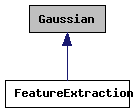
Public Member Functions | |
| Gaussian (int dim=ASR_DEFAULT_VECTORSIZE) | |
| Gaussian (Gaussian *copyFrom, bool shiftGaussian=true) | |
| Gaussian (Gaussian *model1, Gaussian *model2, double rate) | |
| Gaussian (FILE *inFile, int dim) | |
| ~Gaussian () | |
| int | getNrTrainingSamples () const |
| int | dim () const |
| Vector * | getMean () const |
| double | getCP () const |
| Vector * | getVariance () const |
| virtual double | getP (Vector *observation) |
| virtual double | getLogP (Vector *observation) |
| void | setVariance (const Vector *v) |
| void | setMean (Vector *v) |
| void | storeData (FILE *outFile) |
| void | storeSAT (FILE *outFile) |
| void | appendSAT (FILE *outFile) |
| void | train (Gaussian *trainG) |
| void | train (double factor, Vector *observation, Gaussian *doSat=NULL) |
| double | trainFinish (bool cleanUp=true, double minVar=GAUSSIAN_VARIANCE_MINIMUM) |
| void | shiftMean (int shiftFactor=1) |
| double | getTrainingDenominator (void) |
| double | getCoSim (Gaussian *g1, Gaussian *g2) |
| double | getKLDistance (Gaussian *g2) |
| double | getNormDistance () |
| void | moveModel (Gaussian *model, double factor) |
| void | mapAdaptMean () |
| void | adapt_setInitialNode (Adapt_AM_TreeNode *node) |
| void | adapt_setNode () |
| void | adapt_setHelperMatrices () |
| void | adapt_setVarTrans () |
| void | adapt_adaptVar () |
| void | adapt_adapt () |
| void | adapt_unAdapt () |
| void | adapt_clear () |
| void | writeAccumulators (FILE *file, FILE *fileF=NULL, FILE *fileST=NULL, bool doBinary=false) |
| void | trainMMI (FILE *fileEnum, FILE *fileDenom) |
| void | addAccumulators (FILE *file) |
| void | printModel (FILE *fileMean, FILE *fileVariance) |
| void | printInfo (Vector *v) |
| void | printGaussian (void) |
Protected Member Functions | |
| void | calculateCP () |
| void | enterTrainingMode (bool mmiTraining=false) |
Protected Attributes | |
| double | CP |
| CP is the part of the normal distribution calculation that can be done before-hand. | |
| Vector * | varianceVector |
| Vector * | meanVector |
| TrainGaussian * | trainPars |
| TrainGaussian * | mmi_trainPars |
| double | helper_meanJKProd |
Detailed Description
Using Gaussian objects, single gaussians can be trained and used.In order to form a gaussian, the user must provide Gaussian objects with training samples. The object will set its mean Vector and variance Vector according to these samples. With getP() the user can request the likelihood that the gaussian would produce a particular observation.
Constructor & Destructor Documentation
| Gaussian::Gaussian | ( | int | dimensions = ASR_DEFAULT_VECTORSIZE |
) |
The constructor initialises the gaussian. The variance is set to 100 (very big), and the mean is set to all zero.
References calculateCP(), meanVector, mmi_trainPars, Vector::setAllValues(), trainPars, and varianceVector.
Referenced by FeatureExtraction::setNormalization().

| Gaussian::Gaussian | ( | Gaussian * | copyFrom, | |
| bool | shiftGaussian = true | |||
| ) |
This constructor creates an identical copy from another Gaussian.
References Vector::addElements(), calculateCP(), Vector::copyVector(), Vector::getMaxElement(), meanVector, mmi_trainPars, Vector::multiplyElements(), Vector::sqrtElements(), trainPars, and varianceVector.
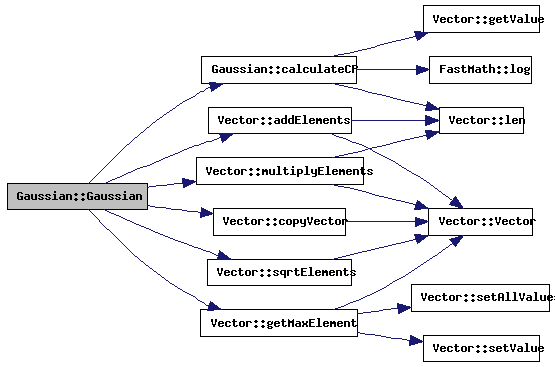
This constructor creates a Gaussian with mean inbetween the mean of model1 and model2.
References Vector::addElements(), calculateCP(), Vector::copyVector(), meanVector, mmi_trainPars, Vector::multiplyElements(), trainPars, and varianceVector.

| Gaussian::Gaussian | ( | FILE * | inFile, | |
| int | dim | |||
| ) |
Reads the Gaussian parameters (mean and variance Vectors) from file.
References calculateCP(), meanVector, mmi_trainPars, trainPars, and varianceVector.

| Gaussian::~Gaussian | ( | ) |
The destructor deletes the variance Vector and the mean Vector.
References meanVector, mmi_trainPars, TrainGaussian::numeratorMean, TrainGaussian::numeratorVariance, trainPars, TrainGaussian::unAdaptedMeanVector, and varianceVector.
Member Function Documentation
| void Gaussian::adapt_adapt | ( | ) |
The Gaussian object will adapt its mean Vector with use of the adaptation matrix that is calculated by the Adapt_AM_TreeNode adaptation node that the Gaussian is registered to. The old mean Vector is kept in memory and can be restored by calling adapt_unAdapt().
References TrainGaussian::adaptNode, Vector::copyVector(), enterTrainingMode(), Vector::getValue(), Vector::len(), meanVector, Vector::setValue(), trainPars, TrainGaussian::unAdaptedMeanVector, varianceVector, and Adapt_AM_TreeNode::W.
Referenced by MixGaussian::adapt_adapt().

| void Gaussian::adapt_adaptVar | ( | ) |
- Todo:
- docs
References TrainGaussian::adaptNode, Vector::multiplyElements(), trainPars, Adapt_AM_TreeNode::varDenom, varianceVector, and Adapt_AM_TreeNode::varTrans.
Referenced by MixGaussian::adapt_adaptVar().

| void Gaussian::adapt_clear | ( | ) |
This method will clear all adaptation settings, so that a new adaptation iteration can be started.
References enterTrainingMode(), TrainGaussian::numeratorMean, TrainGaussian::numeratorVariance, Vector::setAllValues(), TrainGaussian::trainingDenominator, and trainPars.
Referenced by MixGaussian::adapt_clear().

| void Gaussian::adapt_setHelperMatrices | ( | ) |
This method adds its mean vector statistics to the helper matrix of the adaptation node it is registered to.
References TrainGaussian::adaptNode, AUG_P, AUG_P_PLUS_ONE, AUG_X, AUG_Y, AUG_Y_TIMES_VECTOR, Adapt_AM_TreeNode::AUGMENTED_ALL, Vector::divideElements(), enterTrainingMode(), Vector::getValue(), Vector::len(), meanVector, TrainGaussian::numeratorMean, Vector::setAllValues(), TrainGaussian::trainingDenominator, trainPars, and varianceVector.
Referenced by MixGaussian::adapt_setHelperMatrices().

| void Gaussian::adapt_setInitialNode | ( | Adapt_AM_TreeNode * | node | ) |
The SMAPLR adaptation starts with creating one single cluster (node) at which all gaussians in the system will need to register. The method adapt_setInitialNode() will set the Gaussian in training mode (enterTrainingMode()) and add its mean vector to the training pool of the adaptation cluster (Adapt_AM_TreeNode).
References TrainGaussian::adaptNode, Adapt_AM_TreeNode::denominator, enterTrainingMode(), Adapt_AM_TreeNode::meanGaussian, meanVector, train(), TrainGaussian::trainingDenominator, and trainPars.
Referenced by MixGaussian::adapt_setInitialNode().

| void Gaussian::adapt_setNode | ( | ) |
The Gaussian has registered at least once to an adaptation node when this method is called. The first time adapt_setInitialNode() shall be used. This method will calculate which one of the two Adapt_AM_TreeNode children has a mean vector closest to the mean vector of the Gaussian itself. It will register to the closest child adaptation node and add its mean vector to the adaptation training pool.
References TrainGaussian::adaptNode, Adapt_AM_TreeNode::childLeft, Adapt_AM_TreeNode::childRight, Adapt_AM_TreeNode::denominator, enterTrainingMode(), getP(), Adapt_AM_TreeNode::meanGaussian, meanVector, train(), TrainGaussian::trainingDenominator, and trainPars.
Referenced by MixGaussian::adapt_setNode().

| void Gaussian::adapt_setVarTrans | ( | ) |
- Todo:
- docs
References TrainGaussian::adaptNode, Vector::addElements(), Vector::copyVector(), Vector::divideElements(), meanVector, Vector::multiplyElements(), TrainGaussian::numeratorMean, TrainGaussian::numeratorVariance, Vector::substractElements(), TrainGaussian::trainingDenominator, trainPars, Adapt_AM_TreeNode::varDenom, varianceVector, and Adapt_AM_TreeNode::varTrans.
Referenced by MixGaussian::adapt_setVarTrans().

| void Gaussian::adapt_unAdapt | ( | ) |
The Gaussian object will adapt its mean Vector with use of the adaptation matrix that is calculated by the Adapt_AM_TreeNode adaptation node that the Gaussian is registered to when the method adapt_adapt() is called. The method adapt_unAdapt() will restore the old mean Vector that is kept in memory.
References enterTrainingMode(), meanVector, trainPars, and TrainGaussian::unAdaptedMeanVector.
Referenced by MixGaussian::adapt_unAdapt().

| void Gaussian::addAccumulators | ( | FILE * | inFile | ) |
This method will read accumulators from file
References Vector::addElements(), enterTrainingMode(), WriteFileLittleBigEndian::freadEndianSafe(), Vector::len(), TrainGaussian::numeratorMean, TrainGaussian::numeratorVariance, TrainGaussian::trainingDenominator, and trainPars.
Referenced by MixGaussian::addAccumulators().

| void Gaussian::appendSAT | ( | FILE * | inFile | ) |
Load training data from file and append it to the training parameters.
References Vector::addElements(), enterTrainingMode(), WriteFileLittleBigEndian::freadEndianSafe(), TrainGaussian::lastTrainingWeight, Vector::len(), TrainGaussian::numeratorMean, TrainGaussian::numeratorVariance, TrainGaussian::trainingDenominator, and trainPars.
Referenced by MixGaussian::appendSAT().

| void Gaussian::calculateCP | ( | void | ) | [protected] |
Calculates the CP and logCP. The CP is 1 devided by the square root from the determinant of the variance vector:
References CP, Vector::getValue(), Vector::len(), FastMath::log(), and varianceVector.
Referenced by Gaussian(), mapAdaptMean(), setMean(), setVariance(), shiftMean(), trainFinish(), and trainMMI().
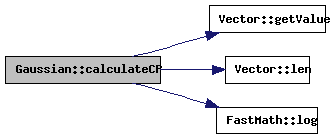
| int Gaussian::dim | ( | ) | const [inline] |
References Vector::len(), and varianceVector.
Referenced by enterTrainingMode(), MixGaussian::MixGaussian(), and FeatureExtraction::setNormalization().

| void Gaussian::enterTrainingMode | ( | bool | mmiTraining = false |
) | [protected] |
In order to safe memory, Gaussian training parameters are grouped in a TrainGaussian structure. Each Gaussian object contains a NULL pointer (trainPars) of type TrainGaussian. When a training method is called and the trainPars variable is NULL, the method enterTrainingMode() is automatically called. This method will create the TrainGaussian structure and initialise its variables.
References TrainGaussian::adaptNode, dim(), TrainGaussian::lastTrainingWeight, Vector::len(), meanVector, mmi_trainPars, TrainGaussian::numeratorMean, TrainGaussian::numeratorVariance, Vector::setAllValues(), TrainGaussian::trainingDenominator, TrainGaussian::trainingSamples, trainPars, and TrainGaussian::unAdaptedMeanVector.
Referenced by adapt_adapt(), adapt_clear(), adapt_setHelperMatrices(), adapt_setInitialNode(), adapt_setNode(), adapt_unAdapt(), addAccumulators(), appendSAT(), getTrainingDenominator(), storeSAT(), train(), trainFinish(), trainMMI(), and writeAccumulators().

References Vector::distance(), Vector::len(), meanVector, Vector::multiplyVector(), Vector::setAllValues(), and Vector::substractElements().
Referenced by MixGaussian::getCoSim().
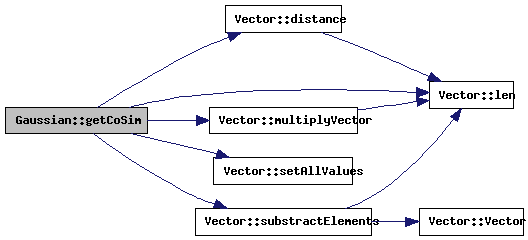
| double Gaussian::getCP | ( | ) | const [inline] |
| double Gaussian::getKLDistance | ( | Gaussian * | g2 | ) |
References Vector::getValue(), Vector::len(), meanVector, and varianceVector.
Referenced by MixGaussian::getKLDistance().

| double Gaussian::getLogP | ( | Vector * | observation | ) | [virtual] |
Returns the chance that an observation is produced by this Gaussian (in log)
References Vector::calculateEPart(), CP, meanVector, and varianceVector.
Referenced by TrainPhoneModel::train().

| Vector* Gaussian::getMean | ( | ) | const [inline] |
References meanVector.
Referenced by FeaturePool::fillBuffer_TextFormat(), FeatureExtraction::finishClusterCMVN(), FeaturePool::getAverageEnergy(), MixGaussian::initializeFastCalc(), Train_Segmenter::mergeClusters(), TrainPhoneModel::normalize(), SpeakerRecognition::runTrials(), FeaturePool::setFilter(), ShoutOnline::ShoutOnline(), and SpeakerRecognition::SpeakerRecognition().
| double Gaussian::getNormDistance | ( | ) |
References Vector::getValue(), Vector::len(), meanVector, and varianceVector.
Referenced by MixGaussian::getNormDistance().

| int Gaussian::getNrTrainingSamples | ( | ) | const [inline] |
References TrainGaussian::trainingSamples, and trainPars.
| double Gaussian::getP | ( | Vector * | observation | ) | [virtual] |
Returns the chance that an observation is produced by this Gaussian.
References Vector::calculateEPart(), CP, meanVector, and varianceVector.
Referenced by adapt_setNode(), MixGaussian::count(), and MixGaussian::getSumHist().

| double Gaussian::getTrainingDenominator | ( | void | ) |
Returns the training denominator. This is basically the number of training observations used during the training phase.
References enterTrainingMode(), TrainGaussian::lastTrainingWeight, and trainPars.
Referenced by MixGaussian::trainFinish().

| Vector* Gaussian::getVariance | ( | ) | const [inline] |
References varianceVector.
Referenced by FeaturePool::createNewPool(), FeaturePool::fillBuffer_TextFormat(), FeatureExtraction::finishClusterCMVN(), FeaturePool::getAverageEnergy(), MixGaussian::initializeFastCalc(), Train_Segmenter::mergeClusters(), TrainPhoneModel::normalize(), SpeakerRecognition::runTrials(), FeaturePool::setFilter(), ShoutOnline::ShoutOnline(), and SpeakerRecognition::SpeakerRecognition().
| void Gaussian::mapAdaptMean | ( | ) |
- Todo:
- docs
References Vector::addElements(), calculateCP(), Vector::getDeterminant(), Vector::len(), FastMath::log(), meanVector, Vector::multiplyElements(), TrainGaussian::numeratorMean, TrainGaussian::numeratorVariance, Vector::setAllValues(), TrainGaussian::trainingDenominator, TrainGaussian::trainingSamples, TrainGaussian::trainP, trainPars, and varianceVector.
Referenced by MixGaussian::mapAdaptMeans().
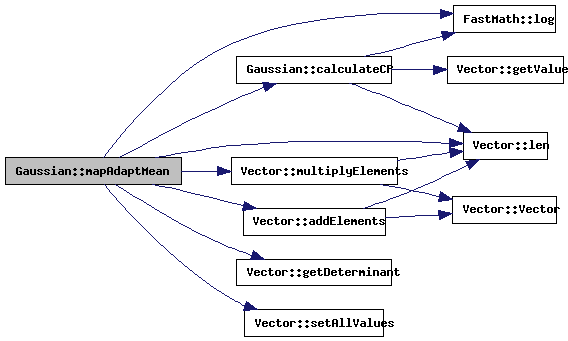
| void Gaussian::moveModel | ( | Gaussian * | model, | |
| double | factor | |||
| ) |
- Todo:
- docs
References Vector::addElements(), meanVector, and Vector::multiplyElements().
Referenced by MixGaussian::moveModelGaussians().

| void Gaussian::printGaussian | ( | void | ) |
Prints the gaussian to the standard output for debugging purposes.
References meanVector, Vector::printVector(), and varianceVector.
Referenced by MixGaussian::printMixGaussian().

| void Gaussian::printInfo | ( | Vector * | v | ) |
References Vector::addElements(), and meanVector.
Referenced by MixGaussian::printInfo().

| void Gaussian::printModel | ( | FILE * | fileMean, | |
| FILE * | fileVariance | |||
| ) |
References Vector::getValue(), Vector::len(), meanVector, and varianceVector.
Referenced by MixGaussian::printModel().

| void Gaussian::setMean | ( | Vector * | v | ) |
Sets the mean of the Gaussian
References calculateCP(), meanVector, and Vector::setAllValues().
Referenced by MixGaussian::addGaussian(), and MixGaussian::getSumHist().

| void Gaussian::setVariance | ( | const Vector * | v | ) |
Sets the variance of the Gaussian
References calculateCP(), Vector::setAllValues(), and varianceVector.
Referenced by MixGaussian::getSumHist().

| void Gaussian::shiftMean | ( | int | shiftFactor = 1 |
) |
Shifts the mean Vector by -0.2*shiftFactor of the variance Vector. shiftFactor may be negative
References Vector::addElements(), calculateCP(), Vector::getMaxElement(), meanVector, Vector::multiplyElements(), Vector::sqrtElements(), and varianceVector.
Referenced by MixGaussian::shiftBestGaussian(), Adapt_AM_TreeNode::split(), MixGaussian::splitAllGaussians(), and MixGaussian::splitBestGaussian().
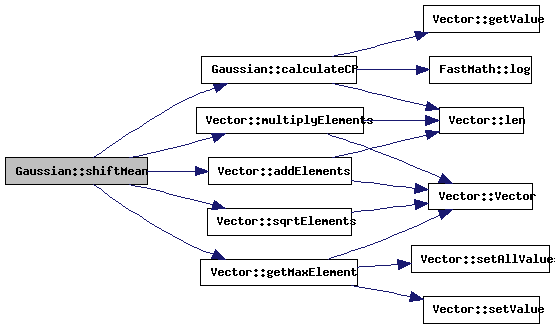
| void Gaussian::storeData | ( | FILE * | outFile | ) |
Writes the Gaussian parameters (mean and variance Vectors) to file.
References meanVector, Vector::storeData(), and varianceVector.
Referenced by MixGaussian::storeData().

| void Gaussian::storeSAT | ( | FILE * | outFile | ) |
Writes training data to file.
References enterTrainingMode(), TrainGaussian::numeratorMean, TrainGaussian::numeratorVariance, Vector::storeData(), TrainGaussian::trainingDenominator, and trainPars.
Referenced by MixGaussian::storeSAT().

Train the Gaussian as follows:
The training factor (input parameter) is added to the denominator. When factor is one, this means that an entire observation is added to the training pool. If 0.0 < factor < 1.0, the observation is seen as being partly mapped on this gaussian.
Literature: Frederick Jelinek, "Statistical Methods for Speech Recognition": page 30 for parameter (mean and variance) estimation.
References Vector::addElements(), Vector::copyVector(), enterTrainingMode(), TrainGaussian::lastTrainingWeight, meanVector, Vector::multiplyElements(), TrainGaussian::numeratorMean, TrainGaussian::numeratorVariance, Vector::substractElements(), TrainGaussian::trainingDenominator, TrainGaussian::trainingSamples, and trainPars.

| void Gaussian::train | ( | Gaussian * | trainG | ) |
Train the Gaussian as follows:
The training data calculated for another Gaussian is added to the training data of this Gaussian. This is used for quickly determine an optimal clustering of single Gaussian observation models.
References Vector::addElements(), enterTrainingMode(), TrainGaussian::lastTrainingWeight, TrainGaussian::numeratorMean, TrainGaussian::numeratorVariance, TrainGaussian::trainingDenominator, TrainGaussian::trainingSamples, and trainPars.
Referenced by adapt_setInitialNode(), adapt_setNode(), FeatureExtraction::createFeaturesUntilFrame(), FeaturePool::createNewPool(), FeaturePool::getAverageEnergy(), Train_Segmenter::mergeClusters(), TrainPhoneModel::normalize(), SpeakerRecognition::runTrials(), FeaturePool::setFilter(), TrainPhoneModel::train(), and MixGaussian::train().

| double Gaussian::trainFinish | ( | bool | cleanUp = true, |
|
| double | minVar = GAUSSIAN_VARIANCE_MINIMUM | |||
| ) |
Used to finish the training procedure.
Literature: Frederick Jelinek, "Statistical Methods for Speech Recognition": page 30 for parameter (mean and variance) estimation.
References calculateCP(), enterTrainingMode(), Vector::getDeterminant(), Vector::len(), FastMath::log(), meanVector, Vector::minimizeElements(), Vector::multiplyElements(), TrainGaussian::numeratorMean, TrainGaussian::numeratorVariance, Vector::setAllValues(), Vector::substractElements(), TrainGaussian::trainingDenominator, TrainGaussian::trainingSamples, TrainGaussian::trainP, trainPars, and varianceVector.
Referenced by FeatureExtraction::createFeaturesUntilFrame(), FeaturePool::createNewPool(), FeatureExtraction::doFeatureExtraction(), FeatureExtraction::finishClusterCMVN(), FeatureExtraction::finishExtraction(), MixGaussian::finishSAT(), FeaturePool::getAverageEnergy(), FeatureExtraction::getOnlineVector(), Train_Segmenter::mergeClusters(), TrainPhoneModel::normalize(), SpeakerRecognition::runTrials(), FeaturePool::setFilter(), Adapt_AM_TreeNode::split(), TrainPhoneModel::train(), and MixGaussian::trainFinish().
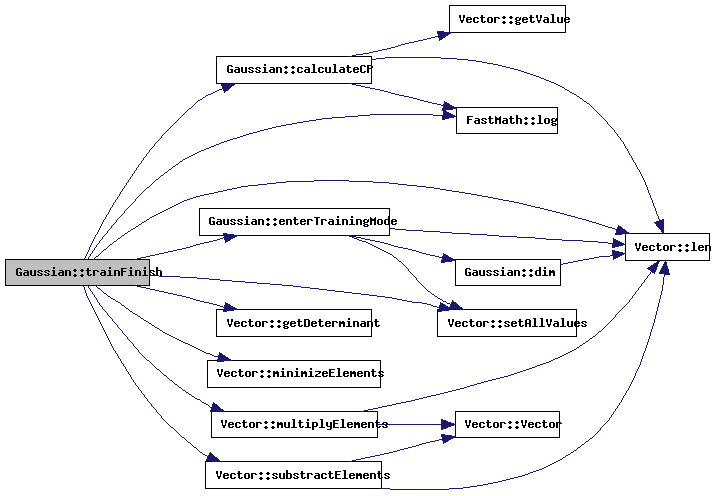
| void Gaussian::trainMMI | ( | FILE * | fileEnum, | |
| FILE * | fileDenom | |||
| ) |
This method will read accumulators from file and perform MMI
References Vector::addElements(), calculateCP(), enterTrainingMode(), WriteFileLittleBigEndian::freadEndianSafe(), Vector::getDeterminant(), Vector::len(), FastMath::log(), meanVector, Vector::minimizeElements(), mmi_trainPars, Vector::multiplyElements(), TrainGaussian::numeratorMean, TrainGaussian::numeratorVariance, Vector::setAllValues(), Vector::substractElements(), TrainGaussian::trainingDenominator, TrainGaussian::trainingSamples, TrainGaussian::trainP, trainPars, and varianceVector.
Referenced by MixGaussian::trainMMI().

| void Gaussian::writeAccumulators | ( | FILE * | outFile, | |
| FILE * | outFileF = NULL, |
|||
| FILE * | outFileST = NULL, |
|||
| bool | doBinary = false | |||
| ) |
This method will write accumulators to file
References enterTrainingMode(), Vector::getValue(), Vector::len(), TrainGaussian::numeratorMean, TrainGaussian::numeratorVariance, Vector::storeData(), TrainGaussian::trainingDenominator, and trainPars.
Referenced by MixGaussian::writeAccumulators().
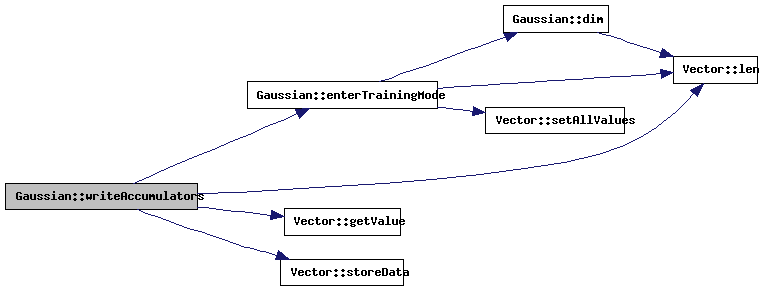
Member Data Documentation
double Gaussian::CP [protected] |
CP is the part of the normal distribution calculation that can be done before-hand.
Referenced by calculateCP(), getCP(), getLogP(), and getP().
double Gaussian::helper_meanJKProd [protected] |
Vector* Gaussian::meanVector [protected] |
Referenced by adapt_adapt(), adapt_setHelperMatrices(), adapt_setInitialNode(), adapt_setNode(), adapt_setVarTrans(), adapt_unAdapt(), FeatureExtraction::createFeaturesUntilFrame(), FeatureExtraction::doFeatureExtraction(), enterTrainingMode(), MixGaussian::fillDistanceArray(), FeatureExtraction::finishExtraction(), Gaussian(), getCoSim(), getKLDistance(), getLogP(), getMean(), getNormDistance(), FeatureExtraction::getOnlineVector(), getP(), mapAdaptMean(), moveModel(), printGaussian(), printInfo(), printModel(), setMean(), shiftMean(), storeData(), train(), trainFinish(), trainMMI(), and ~Gaussian().
TrainGaussian* Gaussian::mmi_trainPars [protected] |
Referenced by enterTrainingMode(), Gaussian(), trainMMI(), and ~Gaussian().
TrainGaussian* Gaussian::trainPars [protected] |
Referenced by adapt_adapt(), adapt_adaptVar(), adapt_clear(), adapt_setHelperMatrices(), adapt_setInitialNode(), adapt_setNode(), adapt_setVarTrans(), adapt_unAdapt(), addAccumulators(), appendSAT(), enterTrainingMode(), Gaussian(), getNrTrainingSamples(), getTrainingDenominator(), mapAdaptMean(), storeSAT(), train(), trainFinish(), trainMMI(), writeAccumulators(), and ~Gaussian().
Vector* Gaussian::varianceVector [protected] |
Referenced by adapt_adapt(), adapt_adaptVar(), adapt_setHelperMatrices(), adapt_setVarTrans(), calculateCP(), FeatureExtraction::createFeaturesUntilFrame(), dim(), FeatureExtraction::doFeatureExtraction(), FeatureExtraction::finishExtraction(), Gaussian(), getKLDistance(), getLogP(), getNormDistance(), FeatureExtraction::getOnlineVector(), getP(), getVariance(), mapAdaptMean(), printGaussian(), printModel(), setVariance(), shiftMean(), storeData(), trainFinish(), trainMMI(), and ~Gaussian().